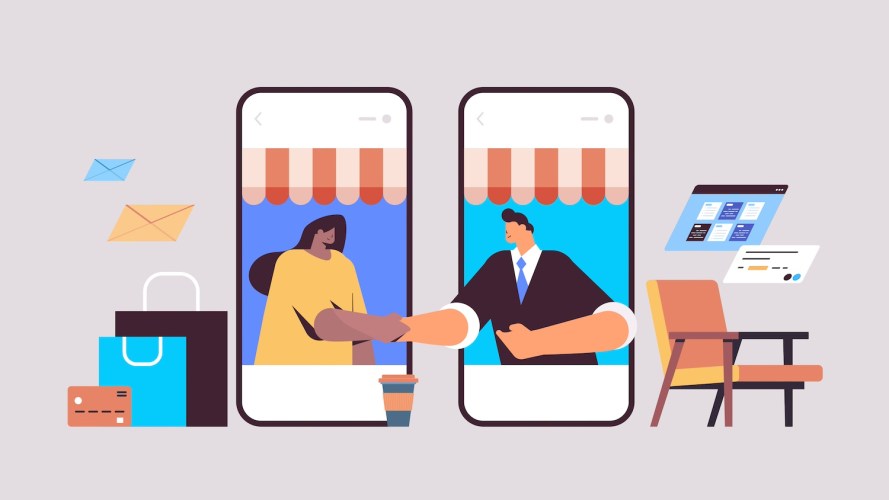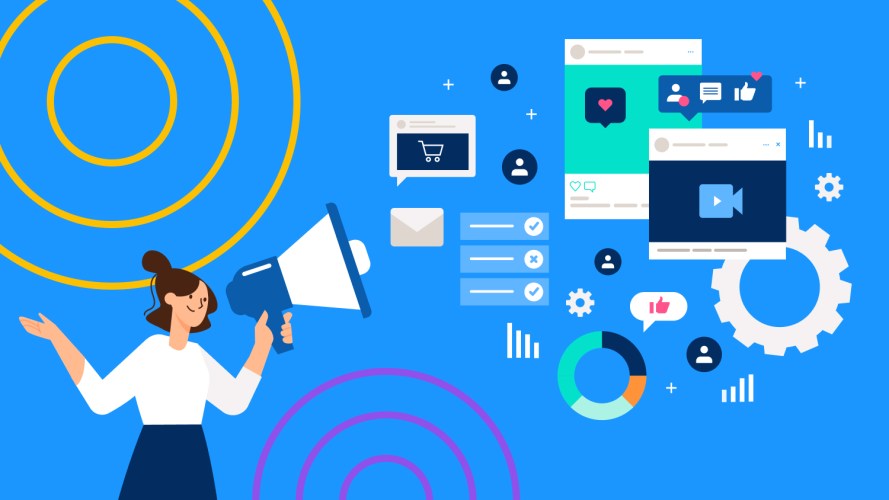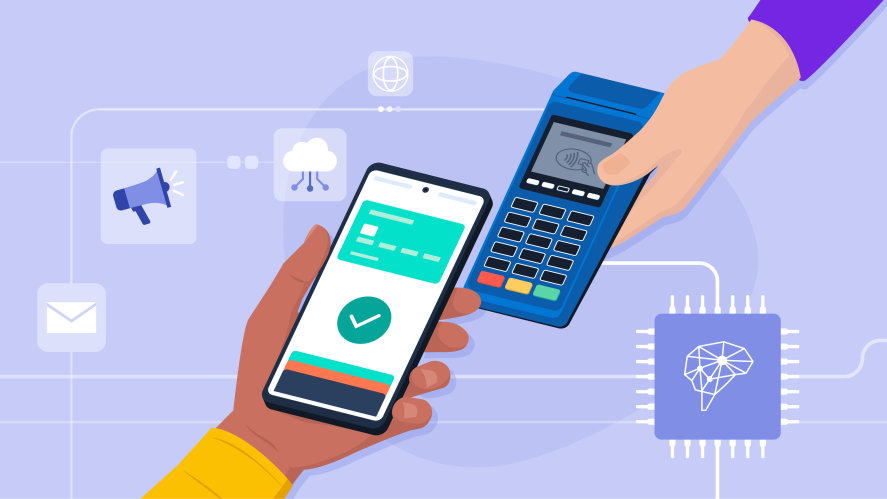How Personalized Marketing Keeps Customers Past the Honeymoon Stage

You’ve got to focus on the whole journey — not just the conversion — to keep customers engaged long-term.
Your guide to personalized marketing
- What is personalized marketing?
- The 6 do’s and don’ts of personalized marketing
- Personalized marketing in action
- How Salesforce uses Data Cloud to close deals faster
It feels like you’ve found “the one” — a customer ready for a long-lasting brand relationship built on personalized marketing. But then, just as quickly as the sparks fly, they fizzle out. Engagement plummets, and those once-enthusiastic customers disappear. What went wrong?
In the world of personalized marketing, making the wrong moves can turn a promising relationship into a fleeting encounter. The truth is, our data shows that 81% of customers expect faster interactions as technology advances, and a whopping 73% crave better personalization. Without these, you risk losing customers because of poor service, which is the number one reason customers stop purchasing.
With timely data at your fingertips, influencing customer behavior seems like a slam dunk. But there’s a catch: not using all the data you have available can negatively impact customer experiences — and push customers away faster than you can say “unsubscribe.”
So, what can you do to build one personalized marketing journey rather than a series of personalized, yet disparate, interactions? First, let’s define what personalized marketing is, then cover some do’s and don’ts as you plan for better long-term customer relationships.
What is personalized marketing?
Personalized marketing ditches the one-size-fits-all approach, using data to tailor messages and offerings to individual customers. This can range from including a customer’s name in an email, to recommending products based on past purchases, to tailoring customer conversations with chatbots powered by artificial intelligence (AI). Done right, it fosters loyalty and boosts revenue. Done wrong, it becomes annoying and intrusive.
What constitutes a “personalized” experience continues to evolve, and there’s a stark difference between how marketing teams are adapting. We found that more than half of marketers take a lifecycle approach to personalization — targeting potential customers with awareness campaigns and nurturing existing ones with product support and loyalty programs.
During that journey, marketers engage customers across an average of 10 channels. And that’s exactly what customers expect. But, access to up-to-date data can make it difficult to reach customers across all of those channels — much less influence them to take the next step.
Just like any relationship, personalized marketing requires effort to make it work. Companies have to collect and analyze customer data responsibly, while ensuring it translates into clear audience segments. They also have to share this customer data across departments to create a truly connected experience. Every interaction, big or small, counts and can make or break a relationship.
Maintaining personalization also requires constant monitoring and adaptation — a challenge for businesses with limited resources. Here’s where size comes in. Large enterprises often have more data that requires the infrastructure and data analysis capabilities to execute complex personalization strategies.
Small businesses, on the other hand, may rely on simpler tactics to apply customer preferences or offer targeted promotions. While the scale differs, the core idea remains — understanding your audience and tailoring your marketing to resonate with them. But just like in real-world relationships, rushing things or being overly clingy can lead to disaster.
The 6 do’s and don’ts of personalized marketing
Imagine getting served irrelevant ads, or worse, recommendations for something you already bought. The key to avoid losing your customer is building trust with your audience. Flip your relationship from doomed to devoted with these tips.
1. Don’t rush the “get to know you” phase
Sure, you want to personalize, but not before you understand your audience’s needs. It’s just as important as knowing if your partner likes coffee or tea, roses or tulips, sweet or salty.
Take time to collect accurate data and segment your audience based on this data. Look beyond demographics and delve into past campaign interactions to form a deeper understanding of their preferences. You need all the information about a customer to truly know them — and that data can live anywhere, so don’t let data live trapped in silos.
2. Don’t forget to collaborate
A truly successful customer relationship thrives on open collaboration between departments and shared understanding of the customer. This requires data that’s securely accessible and actionable across the business. Marketing has customer engagement activity, sales has lead details, and service has case history, and commerce has past purchases. Break down departmental silos and share the customer data to create deeper connections, anticipate customer needs, and streamline processes for the future.
3. Don’t be selfish
Think of customer data as a two-way street. The more information they share (with clear explanations of how it’s used), the more you can tailor their experience. But remember, it’s a give-and-take. Offer valuable content, discounts, or loyalty rewards in return for their insights.
4. Don’t send too many messages
There’s a fine line between interested and overbearing. And you definitely do not want to appear desperate. Using incomplete or inaccurate data can lead to overwhelming customers with irrelevant recommendations in hopes that they respond. Techniques like waterfall segmentation and propensity to purchase scores can prioritize truly interested audiences and prevent oversaturated promotions.
5. Don’t ignore the little details
Make them feel valued with a truly personalized experience in real time. Offer targeted promotions when they’re most engaged and on the channels they frequent. Imagine getting a discount on that jacket you just browsed — on your phone, while you’re still contemplating the purchase. That’s personalization done right.
6. Don’t be inconsistent
Consistency in communication is key. Don’t rely on inaccurate or siloed data to only give them what they want every now and then. Set the bar high by unifying your customer profiles across all platforms and departments. This ensures your messaging stays consistent across all channels, no matter how a customer interacts with your brand — chatting on your website, clicking on an ad, talking to a sales rep, or via email.
Personalized marketing in action
Sure, the honeymoon stage is blissful, but it’s the next phase that makes or breaks the relationship. Let’s see how personalized marketing done right can keep your customers coming back for more.
Consider Northern Trail Outfitters (NTO), a fictional outdoor apparel retailer facing a challenge with stagnant conversion rates on their website. They knew personalization was key, but with a diverse customer base ranging from casual hikers to hardcore mountaineers, a one-size-fits-all approach wouldn’t cut it.
Here’s how they tackled the problem:
Using advertising insights
NTO started by analyzing customer behavior data gleaned from their advertising campaigns. They looked at which ads different customer segments responded to, the products they clicked on, and even their browsing history post-ad click. This provided valuable insights into customer intent and preferences.
Waterfall segmentation with a twist
Instead of a static segmentation based on demographics, NTO implemented a dynamic “waterfall” approach. Here’s how it worked:
- Basic demographics: All website visitors were initially categorized by basic demographics like age and location.
- Behavioral segmentation: Based on browsing behavior, visitors were further segmented and prioritized into subsets of outdoor shoppers, like “Hikers,” “Campers,” or “Rock Climbers.” This ensured each subset was only included in one campaign most relevant to them to avoid oversaturation.
- Real-time personalization: Within each behavioral segment, NTO used up-to-date data to further personalize the experience. For example, a customer buying a climbing rope, who has purchased items in the past, might receive a special offer at checkout, along with recommendations for complementary climbing gear.
By delivering personalized shopping experiences, NTO saw a significant increase in conversion rates. Waterfall segmentation helped them prioritize various subsets of their audience so they could further personalize offers, retain loyal customers, and avoid oversaturation of promotions.
How Salesforce uses Data Cloud to close deals faster
Let’s take another look from a B2B perspective to see how we at Salesforce use our own product (Data Cloud) to cut our time between a lead expressing interest and it being sent to the correct sales rep from 25 minutes to 45 seconds.
Since we process more than 20 million leads every year, that’s a lot of time saved. Previously, our system relied on over 2 million lines of custom code. Now, it’s down to a few thousand lines built natively into our automation platform, Flow.
Data Cloud is more than just a customer data platform for marketers; it’s a data platform built for the entire company. It unifies customer data from any source including website behavior, customer relationship management (CRM) platform interactions, ad performance, and more. This unified data is then accessible to marketers (as well as sales reps, service agents, and merchandisers) who can then activate it to power personalized marketing and connect customer experiences.
Intelligent lead routing
When a prospect expresses interest in our products, the first step in our routing process is to ingest this lead into Data Cloud. We can then perform data transformations on the form submission to enrich the data we’ve collected, with the data we already have on this customer, and create a usable lead record.
To route the lead to the correct individual, we use Data Cloud-powered Flows to assign leads to the correct sales reps, giving them all the info they need to convert.
Automated sales alerts & tasks
From there, we create a dynamic segment of customers who visited a pricing page on our website in the last 24 hours. Whenever one of these leads visited a pricing page, it triggered an instant alert in Slack, specifically tailored for the sales rep assigned to that lead. These alerts are personalized with recommended next steps based on previous interactions and what product or pricing pages were visited.
Using AI for data-driven responses
Using the data garnered from these interactions, we built a holistic view of quality leads and assigned product interest scores with AI-powered predictive models. This helps our sales reps better understand which products key leads are most likely to buy in the future.
With all customer data accessible, reps are not only alerted of hot leads, their conversations with potential customers are more focused and impactful. Using Data Cloud also helped us become much more agile, which changes being implemented in minutes vs. weeks.
Personalized marketing is a balancing act that demands resources and expertise to build lasting customer relationships. But, truly personalized marketing is dependent on data from across the entire business — data that is shared, accessible, and actionable across marketing, sales, service, commerce, and more.
So, ditch the one-size-fits-all approach, invest in your data strategy, and watch your customer relationships blossom with relevant recommendations and experiences that keep them coming back for more. Personalization is all about building relationships, and just like in love, remember that every interaction — big or small, marketing or not — counts.
Say hello to Data Cloud
Want to improve your personalization and break down silos that lead to a disjointed customer experience? Data Cloud brings it all under one platform, having all your teams working together.
































